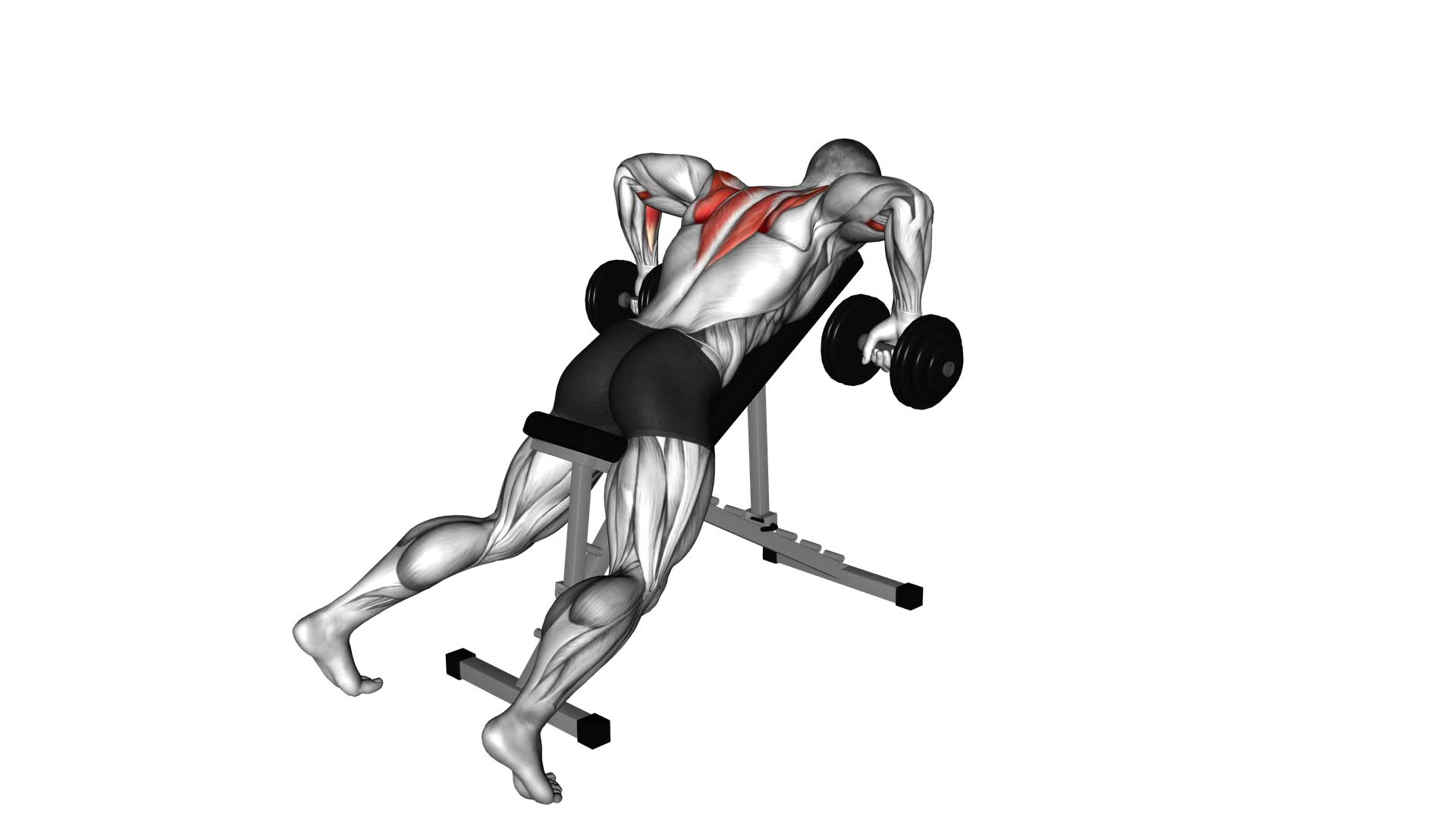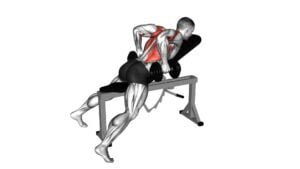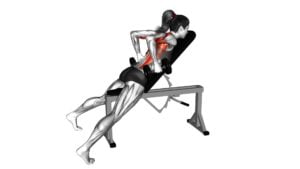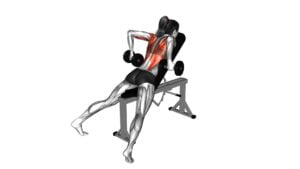Dumbbell Incline Row – Video Exercise Guide & Tips

Are you looking for an effective exercise to strengthen your back muscles? Look no further! The dumbbell incline row is just what you need.
Watch This Exercise Video
In this video exercise guide, we will show you the proper form and technique to maximize your results. Avoid common mistakes and learn variations and progressions to challenge yourself further.
Get ready to take your back workout to the next level with this informative and professional guide.
Key Takeaways
- Strengthens upper back muscles
- Improves posture
- Targets rhomboids, trapezius, and rear deltoids
- Reduces risk of upper back pain
Benefits of the Dumbbell Incline Row
By performing the Dumbbell Incline Row, you can strengthen your upper back and improve your posture. This exercise is an effective way to target your rhomboids, trapezius, and rear deltoids, which are all important muscles for maintaining good posture. The incline position of this exercise puts more emphasis on the upper back muscles compared to the traditional bent-over row.
During the Dumbbell Incline Row, your rhomboids are activated as they pull your shoulder blades together. This helps in retracting your shoulders and improving your posture. The trapezius muscles are also engaged as they stabilize your shoulder blades and assist in pulling the dumbbells towards your chest. Additionally, the rear deltoids are targeted as they assist in the rowing motion.
Including the Dumbbell Incline Row in your workout routine can help strengthen these muscles, leading to improved posture and reduced risk of upper back pain. This exercise can be performed using dumbbells of appropriate weight and an incline bench set to an appropriate angle. Aim for controlled, smooth movements and focus on squeezing your shoulder blades together at the top of the row.
As always, consult with a fitness professional before starting any new exercise routine to ensure proper form and technique.
Equipment Needed for the Exercise
To perform the Dumbbell Incline Row, you'll need a few pieces of equipment. First, you'll need a pair of dumbbells with a weight that challenges you but allows for proper form.
Alternatively, if you don't have dumbbells, you can use resistance bands or even water bottles filled with sand or water.
Remember to prioritize safety by choosing a weight or resistance that you can handle without straining your muscles or compromising your form.
Required Equipment List
You will need dumbbells for the Dumbbell Incline Row exercise. Dumbbells are essential for this exercise as they provide resistance to target your back muscles effectively. It's recommended to use dumbbells that are appropriate for your fitness level and allow you to maintain proper form throughout the exercise.
If you don't have access to dumbbells, you can use alternative equipment such as resistance bands or kettlebells to perform a variation of the exercise. However, it's important to note that using dumbbells provides better stability and control.
When using dumbbells, it's essential to ensure that you have a firm grip on the handles and maintain a neutral spine position to prevent injury.
Always consult with a fitness professional for personalized recommendations and safety guidelines.
Alternatives to Dumbbells
Using resistance bands or kettlebells can be effective alternatives to dumbbells for the Dumbbell Incline Row exercise. If you don't have access to dumbbells, resistance bands are a great option. They provide a similar level of resistance and can be adjusted to meet your strength level. Resistance bands also offer the benefit of constant tension throughout the movement, which can help improve muscle activation.
Kettlebells are another alternative to consider. They provide a different challenge due to their unique shape and center of gravity. Kettlebell exercises, like the renegade row, can target the same muscles as the Dumbbell Incline Row while also engaging your core and stability muscles.
Safety Precautions and Recommendations
If you don't have access to dumbbells, it's important to consider the safety precautions and equipment needed for the Dumbbell Incline Row exercise. Safety should always be a priority when performing any exercise to prevent injuries.
Before starting the exercise, make sure you have a sturdy and stable incline bench to support your body. This will ensure proper form and stability throughout the movement.
Additionally, it's recommended to use a pair of dumbbells that are appropriate for your strength level. Start with a weight that allows you to maintain proper form and gradually increase the weight as you become more comfortable and stronger.
If you're unable to perform the exercise with dumbbells, you can modify it by using resistance bands or even household objects like water bottles or canned goods.
Remember to always listen to your body and consult with a professional if you have any concerns or injuries.
Proper Form and Technique
To perform the dumbbell incline row correctly, ensure that you maintain a neutral spine throughout the exercise. This means keeping your back straight and avoiding any excessive arching or rounding. It's important to engage your core muscles to support your spine and maintain stability.
To begin the exercise, lie face down on an incline bench with a dumbbell in each hand. Your arms should be fully extended and hanging straight down. Keep your feet flat on the ground for stability.
As you row the dumbbells up towards your chest, focus on squeezing your shoulder blades together. Keep your elbows close to your body and avoid any swinging or jerking motions.
There are several variations and progressions you can try to make the exercise more challenging. One option is to increase the weight of the dumbbells. Another option is to increase the incline of the bench, which will shift more of the focus onto your upper back muscles. You can also try performing the exercise with one arm at a time to isolate each side of your back.
Now that you understand the proper form and technique for the dumbbell incline row, let's move on to discussing common mistakes to avoid.
Common Mistakes to Avoid
To avoid common mistakes when performing the dumbbell incline row, focus on maintaining proper form and technique. Here are three common mistakes to avoid:
- Using too much weight: One of the most common mistakes people make is using weights that are too heavy. This not only compromises your form but also increases the risk of injury. Start with lighter weights and gradually increase the resistance as you become more comfortable and confident in your form.
- Rounding your back: Another mistake to avoid is rounding your back during the exercise. This puts unnecessary strain on your spine and can lead to back pain. Instead, keep your back straight and engage your core muscles to maintain stability throughout the movement.
- Pulling with your arms instead of your back: Many people make the mistake of relying too much on their arm strength instead of engaging their back muscles. Remember, the primary focus of the dumbbell incline row is to target your back muscles. Focus on pulling the dumbbells towards your chest using your back muscles, rather than your arms.
Variations and Progressions
To further challenge yourself and continue progressing in your dumbbell incline row workouts, try incorporating variations and progressions into your routine. By adding different dumbbell row variations, you can target different muscle groups and increase the difficulty of the exercise. For example, you can try performing the exercise with a single dumbbell instead of two, which will require more stabilization and engage your core muscles even more. Another variation is the renegade row, where you perform a push-up in between each row, further challenging your upper body strength and stability.
If you're looking for more advanced row progressions, you can try incorporating tempo variations. Slow down the eccentric (lowering) portion of the row to increase time under tension and muscle activation. You can also try performing explosive rows, where you focus on accelerating the dumbbells during the concentric (lifting) phase of the exercise. This will help develop power and explosiveness in your rowing movement.
Incorporating these variations and progressions into your dumbbell incline row routine won't only keep your workouts interesting, but also allow you to continually challenge yourself and make progress. Now, let's move on to some tips for maximizing your results.
Tips for Maximizing Your Results
Maximize your results by implementing these tips into your dumbbell incline row routine.
- Focus on form: To maximize gains, it's important to maintain proper form throughout the exercise. Keep your back straight, shoulders down, and engage your core. Avoid using momentum or swinging to lift the dumbbells. By performing the exercise with correct form, you'll target the intended muscles more effectively.
- Increase weight gradually: As you become more comfortable with the exercise, gradually increase the weight of the dumbbells. This progressive overload will challenge your muscles and stimulate growth, maximizing gains over time. However, ensure that you can perform the exercise with good form before adding additional weight.
- Prioritize workout efficiency: To maximize your results, incorporate the dumbbell incline row into a well-rounded workout routine. Pair it with other compound exercises, such as squats or bench presses, to engage multiple muscle groups simultaneously. This approach not only saves time but also increases the intensity and efficiency of your workouts.
Frequently Asked Questions
Can the Dumbbell Incline Row Help Improve Posture and Reduce Back Pain?
Improving your posture and reducing back pain are key benefits of the dumbbell incline row exercise. Proper form is crucial to maximize these benefits.
By maintaining a neutral spine and engaging your core, you can target the muscles responsible for posture and back support.
To increase the intensity, gradually increase the weight of the dumbbells or add more repetitions.
Remember to always focus on maintaining proper form to avoid injury and achieve optimal results.
How Heavy Should the Dumbbells Be for Beginners to Start With?
When starting the dumbbell incline row, it's important to choose the right weight. For beginners, it's recommended to start with lighter dumbbells to focus on form and technique. You can begin with weights that are comfortable for you, such as 5-10 pounds.
As you progress and feel more confident, gradually increase the weight. This will help you build strength and avoid injury. Remember, it's better to start light and progress gradually rather than starting too heavy and risking injury.
Is It Necessary to Use an Incline Bench for This Exercise, or Can It Be Done on a Flat Bench as Well?
Using an incline bench for the dumbbell incline row has its benefits. It allows for a greater range of motion, targeting your upper back muscles effectively.
However, it can also be done on a flat bench if you don't have access to an incline bench. Just make sure to maintain proper form and focus on squeezing your shoulder blades together.
Both variations can help strengthen your back muscles and improve posture.
Can the Dumbbell Incline Row Help in Building Upper Body Strength?
Yes, the dumbbell incline row is a great exercise for building upper body strength and increasing muscle. By targeting the muscles in your back, shoulders, and arms, this exercise helps to improve your overall upper body strength.
The incline bench allows for a greater range of motion and targets specific muscles more effectively.
Incorporating the dumbbell incline row into your workout routine can help you achieve your goals of building muscle and increasing upper body strength.
Are There Any Alternatives to the Dumbbell Incline Row Exercise for Those Who May Not Have Access to Dumbbells?
If you don't have access to dumbbells, there are alternatives to the dumbbell incline row exercise. Bodyweight row exercises can be a great substitute.
You can try inverted rows using a suspension trainer or a barbell, or even a simple horizontal row using a table or a sturdy bar. These exercises target similar muscles and can help build upper body strength without the need for dumbbells.
Conclusion
In conclusion, the dumbbell incline row is a highly beneficial exercise that targets the upper back and shoulders. By using proper form and technique, you can avoid common mistakes and maximize your results.
Additionally, by incorporating variations and progressions, you can continue challenging your muscles and improving your strength. Remember to always use the appropriate equipment and follow the tips provided to ensure a safe and effective workout.

Author
Years ago, the spark of my life’s passion ignited in my mind the moment I stepped into the local gym for the first time. The inaugural bead of perspiration, the initial endeavor, the very first surge of endorphins, and a sense of pride that washed over me post-workout marked the beginning of my deep-seated interest in strength sports, fitness, and sports nutrition. This very curiosity blossomed rapidly into a profound fascination, propelling me to earn a Master’s degree in Physical Education from the Academy of Physical Education in Krakow, followed by a Sports Manager diploma from the Jagiellonian University. My journey of growth led me to gain more specialized qualifications, such as being a certified personal trainer with a focus on sports dietetics, a lifeguard, and an instructor for wellness and corrective gymnastics. Theoretical knowledge paired seamlessly with practical experience, reinforcing my belief that the transformation of individuals under my guidance was also a reflection of my personal growth. This belief holds true even today. Each day, I strive to push the boundaries and explore new realms. These realms gently elevate me to greater heights. The unique combination of passion for my field and the continuous quest for growth fuels my drive to break new ground.







